Week 6: Diving Operations
An important part of our research involves diving to perform experiments,
to collect animals, and to measure environmental conditions. While
our team dives often, diving in the Antarctic is far from routine.
Each individual dive is handled by all involved with the utmost focus.
Diving in cold water, particularly under ice, carries with it many hazards
and concerns.
When diving under ice, the first thing that needs to be done is to
cut a dive hole in the sea ice (image 1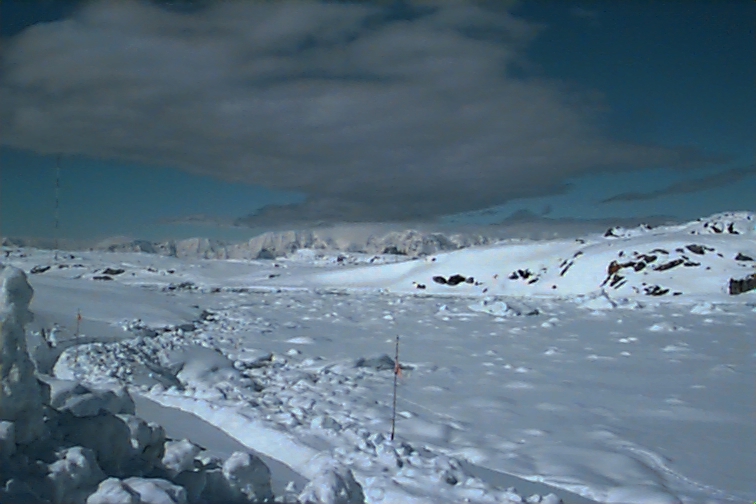 ).
Using a chainsaw, or an ice saw, and a breaker bar (a thick iron bar which
can be used to break up ice), we set out to cut three dive holes (image
2, 3).
Because the dive hole is the only place that a diver can surface, it is
considered a good idea to cut more than one. We cut two accessory
dive holes on either side of the main one, as "emergency exits" should
the divers become disoriented or should they need to surface immediately.
Then we shoveled lines of snow away in the shape of a giant asterisk with
arrows pointing to the dive hole. From the air it must look
not unlike those mysterious crop patterns that are found in England.
However because the snow on the ice blocks light from penetrating the water,
from under the ice the backlit designs can be seen from deep in the water,
directing the diver to the main dive hole.
).
Using a chainsaw, or an ice saw, and a breaker bar (a thick iron bar which
can be used to break up ice), we set out to cut three dive holes (image
2, 3).
Because the dive hole is the only place that a diver can surface, it is
considered a good idea to cut more than one. We cut two accessory
dive holes on either side of the main one, as "emergency exits" should
the divers become disoriented or should they need to surface immediately.
Then we shoveled lines of snow away in the shape of a giant asterisk with
arrows pointing to the dive hole. From the air it must look
not unlike those mysterious crop patterns that are found in England.
However because the snow on the ice blocks light from penetrating the water,
from under the ice the backlit designs can be seen from deep in the water,
directing the diver to the main dive hole.
The most important part of any diver's gear is his or her SCUBA
(Self Contained Underwater Breathing Apparatus). This is the system
of tanks, valves and hoses that allow a diver to be able to breathe air
underwater. In addition, for Antarctic divers the use of a dry suit
is a must. Early Antarctic divers used wet suits, and their dives
were consequently short and very uncomfortable. With the advent of
compressed neoprene and vulcanized rubber suits, it was possible to create
a suit that excluded water, and so the body could be insulated from the
seemingly infinite heat sink that is the Antarctic Ocean. So our
divers would spend a good half an hour gearing up. They put
on, in order, thermal polypropylene underwear, fleece underwear, layers
of socks or thermal booties, the neoprene dry suit (image
4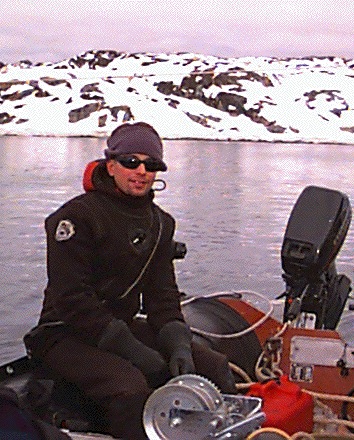 ),
hand insulation (usually wool or polypropylene glove liners), rubber
gloves, wrist sealers, and finally, the dive mask. The suit has weak
points, places that are prone to failure. Perhaps the most common
site of failure are the hand coverings. Because they are not continuous
with the suit, the seal that keeps water from flooding the gloves is the
most common place for water leakage. Many of our dives ended with
the divers coming out of the water with numb hands. The suit doesn't
flood because of an effective seal around the wrists that keeps water out
of the suit. A neck seal also keeps water from leaking in around
the neck. Finally the dive suit's zipper is a weak point of concern.
If it fails, the whole suit floods and the diver is in some serious trouble.
However, great care is taken to keep the zipper in good condition and the
suits are checked for leaks regularly.
),
hand insulation (usually wool or polypropylene glove liners), rubber
gloves, wrist sealers, and finally, the dive mask. The suit has weak
points, places that are prone to failure. Perhaps the most common
site of failure are the hand coverings. Because they are not continuous
with the suit, the seal that keeps water from flooding the gloves is the
most common place for water leakage. Many of our dives ended with
the divers coming out of the water with numb hands. The suit doesn't
flood because of an effective seal around the wrists that keeps water out
of the suit. A neck seal also keeps water from leaking in around
the neck. Finally the dive suit's zipper is a weak point of concern.
If it fails, the whole suit floods and the diver is in some serious trouble.
However, great care is taken to keep the zipper in good condition and the
suits are checked for leaks regularly.
Now it was time to put on the SCUBA gear (image
5). The gear we use consisted of a single air tank which was
connected to two separate regulators. One is used as a back up, should
the first fail. Because of the physics of air decompression, regulators
are particularly prone to malfunction in extremely cold water, such as
that found in the Antarctic. So it is important to have a back up
system. The regulators are each connected to a separate hose that
runs to a mouth piece. There is also a hose that runs from the regulator
directly into the suit. The diver can use the air in the tank to
inflate the suit with air, creating a little more insulation within the
suit from the frigid water. Because the suit is water tight, it is
also airtight, so when it is put on, air gets trapped in the suit, making
the diver buoyant. Regulating buoyancy is a concern to divers because
if a diver ascends from the deep too fast, he or she will experience nitrogen
bubbling out of his or her blood. This condition is commonly referred
to as the bends. There is no treatment for the bends on station,
so prevention is the key. Divers who use dry suits must use
a weightbelt to counteract the buoyancy. The suit also has a set
of venting valves that the diver can use to release air from the suit if
he or she feels that the suit is too buoyant, even for the weightbelt.
The goal is for the diver to remain as close to neutrally buoyant as possible.
Each SCUBA system is equipped with a set of gauges and a small computer
so the diver can keep track of depth, air reserve, and time spent underwater.
All of this data is important particularly when diving under ice, where
it is impossible to just head straight up to the surface in an emergency
(the divers must allow for enough time to swim back to the dive hole).
All told the divers weigh approximately twice as much with all the dive
equipment on.
Once suited up, the divers must carry themselves, weighing three
hundred and fifty pounds or more, to the dive hole. This is difficult,
when foot deep snow lies between you and the dive hole. While the
divers are suiting up, the tenders (Mario and I) go to the dive hole, clear
away any ice that formed over it over night, and lay a down line.
The down line is a rope that is dangled from the surface and serves as
a marker for the divers, and provides them with something that they can
attach their tether to. Diving under ice requires the divers to be
tethered to the surface. Otherwise, if the divers lose their way,
or become disoriented and lose sight of the dive hole, they are in serious
trouble. Open water diving carries none of these concerns, as the
divers can surface wherever they want to. At the dive hole, the equipment
is checked by both the tenders and the divers. The tenders then help
the divers into the water (image
6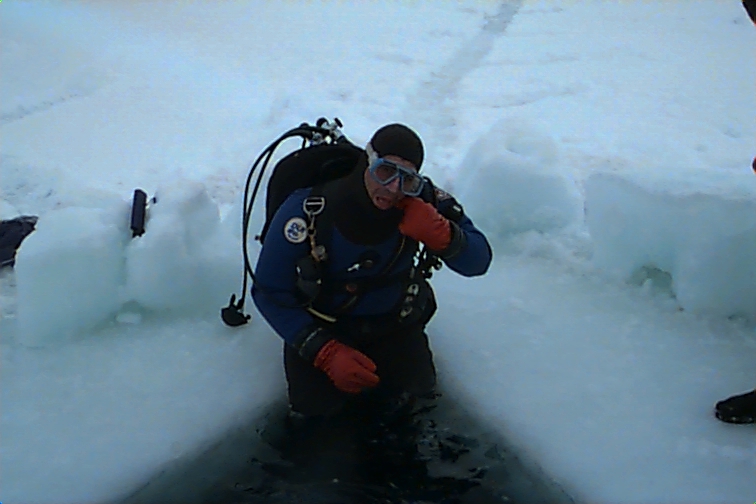 ,
Image
7), and the divers swim out of sight. In the mean time, the tenders
nervously wait around the dive hole, keeping the dive hole clear of ice
and debris, and, when it warranted, keeping a watchful eye out for leopard
seals. Usually we would bring snacks with us, some nuts, or beef
jerky or dried fruit. Something to pass the time (image
8
,
Image
7), and the divers swim out of sight. In the mean time, the tenders
nervously wait around the dive hole, keeping the dive hole clear of ice
and debris, and, when it warranted, keeping a watchful eye out for leopard
seals. Usually we would bring snacks with us, some nuts, or beef
jerky or dried fruit. Something to pass the time (image
8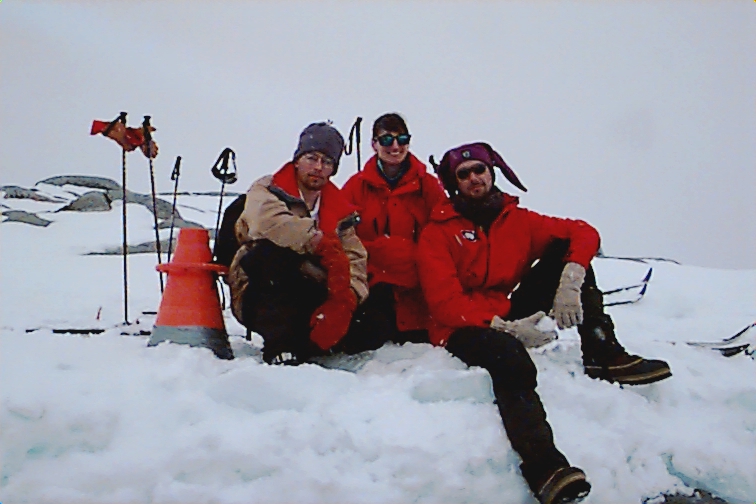 ).
Waiting for the divers to come back up felt like an eternity at times.
We can only imagine what is going on beneath our feet (see "Going
Under in McMurdo", by John Pearse). After about twenty to thirty minutes,
we see groups of bubbles at the surface, a telltale indicator that the
divers are on their way back to the surface. We prepare for them
by clearing away any equipment from around the dive hole. The divers
surface and hand us their bag of goodies (usually animals that they had
collected). Then the tenders help the divers heave themselves out
of the dive hole. Usually the tenders would then bring all the equipment
back to the dive locker, following behind the divers. The divers
must get back to the dive locker soon after leaving the water. Despite
the copious measures taken to insulate them from the water, they still
experience mild hypothermia (a lowering of the body's core temperature),
and so it is very important that they get out of their suits and into a
warm shower as soon after the dive as possible. Usually, one
or more of the divers' gloves will have leaked, and so oftentimes the tenders
will have to help the divers out of their cumbersome drysuits, their own
hands too cold and numb.
).
Waiting for the divers to come back up felt like an eternity at times.
We can only imagine what is going on beneath our feet (see "Going
Under in McMurdo", by John Pearse). After about twenty to thirty minutes,
we see groups of bubbles at the surface, a telltale indicator that the
divers are on their way back to the surface. We prepare for them
by clearing away any equipment from around the dive hole. The divers
surface and hand us their bag of goodies (usually animals that they had
collected). Then the tenders help the divers heave themselves out
of the dive hole. Usually the tenders would then bring all the equipment
back to the dive locker, following behind the divers. The divers
must get back to the dive locker soon after leaving the water. Despite
the copious measures taken to insulate them from the water, they still
experience mild hypothermia (a lowering of the body's core temperature),
and so it is very important that they get out of their suits and into a
warm shower as soon after the dive as possible. Usually, one
or more of the divers' gloves will have leaked, and so oftentimes the tenders
will have to help the divers out of their cumbersome drysuits, their own
hands too cold and numb.
Open water dives are considerably less complicated. Diving
from a boat is much simpler than diving from shore, as the divers can gear
up in the boat, and they don't have to swim out to the site of interest.
The only hazard that exists in open water diving is the presence of leopard
seals. This aggressive but graceful species has been known to threaten
divers, who by comparison are clumsy and ungainly. Our divers carried
narrow piece of PVC piping, one end having been crafted into a sharp spear.
The weapon was dubbed the "leopard seal be cool tool" It was the
divers' only defense from a seal attack. The primary defense against
leopard seal attacks came from the surface. The tenders always keep
a watchful eye out as leopard seals surface frequently, particularly when
they are hunting (this behavior is called spy-hopping). If
one is spotted, then the tenders will rev the boat engine as a signal to
the divers to get out of the water. We have been surprisingly lucky
this season. We only had one unconfirmed sighting during a dive.
Despite all the potential hazards of
diving here, we have completed a successful dive season, without a single
mishap in the water. Primarily due to the expertise of the divers
(image 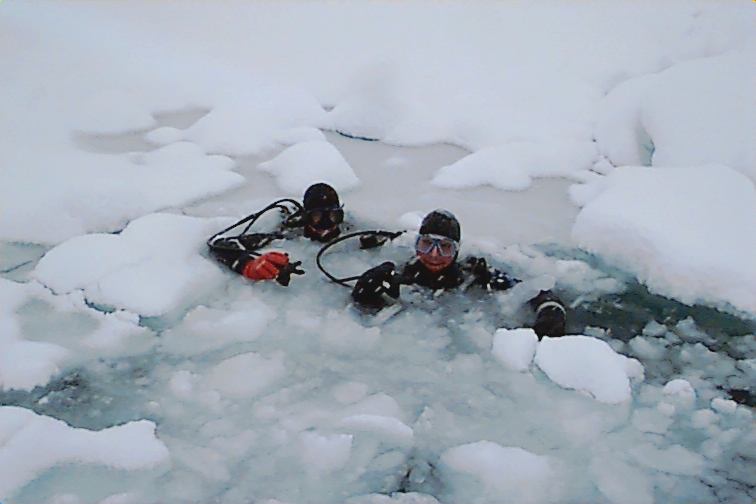 10)
and the careful measures taken by the team, we have been able to collect
the animals and take the measurements we need to complete our research
project here at Palmer Station.
10)
and the careful measures taken by the team, we have been able to collect
the animals and take the measurements we need to complete our research
project here at Palmer Station.
 ).
Using a chainsaw, or an ice saw, and a breaker bar (a thick iron bar which
can be used to break up ice), we set out to cut three dive holes (image
2, 3).
Because the dive hole is the only place that a diver can surface, it is
considered a good idea to cut more than one. We cut two accessory
dive holes on either side of the main one, as "emergency exits" should
the divers become disoriented or should they need to surface immediately.
Then we shoveled lines of snow away in the shape of a giant asterisk with
arrows pointing to the dive hole. From the air it must look
not unlike those mysterious crop patterns that are found in England.
However because the snow on the ice blocks light from penetrating the water,
from under the ice the backlit designs can be seen from deep in the water,
directing the diver to the main dive hole.
).
Using a chainsaw, or an ice saw, and a breaker bar (a thick iron bar which
can be used to break up ice), we set out to cut three dive holes (image
2, 3).
Because the dive hole is the only place that a diver can surface, it is
considered a good idea to cut more than one. We cut two accessory
dive holes on either side of the main one, as "emergency exits" should
the divers become disoriented or should they need to surface immediately.
Then we shoveled lines of snow away in the shape of a giant asterisk with
arrows pointing to the dive hole. From the air it must look
not unlike those mysterious crop patterns that are found in England.
However because the snow on the ice blocks light from penetrating the water,
from under the ice the backlit designs can be seen from deep in the water,
directing the diver to the main dive hole.
 ),
hand insulation (usually wool or polypropylene glove liners), rubber
gloves, wrist sealers, and finally, the dive mask. The suit has weak
points, places that are prone to failure. Perhaps the most common
site of failure are the hand coverings. Because they are not continuous
with the suit, the seal that keeps water from flooding the gloves is the
most common place for water leakage. Many of our dives ended with
the divers coming out of the water with numb hands. The suit doesn't
flood because of an effective seal around the wrists that keeps water out
of the suit. A neck seal also keeps water from leaking in around
the neck. Finally the dive suit's zipper is a weak point of concern.
If it fails, the whole suit floods and the diver is in some serious trouble.
However, great care is taken to keep the zipper in good condition and the
suits are checked for leaks regularly.
),
hand insulation (usually wool or polypropylene glove liners), rubber
gloves, wrist sealers, and finally, the dive mask. The suit has weak
points, places that are prone to failure. Perhaps the most common
site of failure are the hand coverings. Because they are not continuous
with the suit, the seal that keeps water from flooding the gloves is the
most common place for water leakage. Many of our dives ended with
the divers coming out of the water with numb hands. The suit doesn't
flood because of an effective seal around the wrists that keeps water out
of the suit. A neck seal also keeps water from leaking in around
the neck. Finally the dive suit's zipper is a weak point of concern.
If it fails, the whole suit floods and the diver is in some serious trouble.
However, great care is taken to keep the zipper in good condition and the
suits are checked for leaks regularly.
 ,
Image
7), and the divers swim out of sight. In the mean time, the tenders
nervously wait around the dive hole, keeping the dive hole clear of ice
and debris, and, when it warranted, keeping a watchful eye out for leopard
seals. Usually we would bring snacks with us, some nuts, or beef
jerky or dried fruit. Something to pass the time (image
8
,
Image
7), and the divers swim out of sight. In the mean time, the tenders
nervously wait around the dive hole, keeping the dive hole clear of ice
and debris, and, when it warranted, keeping a watchful eye out for leopard
seals. Usually we would bring snacks with us, some nuts, or beef
jerky or dried fruit. Something to pass the time (image
8 ).
Waiting for the divers to come back up felt like an eternity at times.
We can only imagine what is going on beneath our feet (see "Going
Under in McMurdo", by John Pearse). After about twenty to thirty minutes,
we see groups of bubbles at the surface, a telltale indicator that the
divers are on their way back to the surface. We prepare for them
by clearing away any equipment from around the dive hole. The divers
surface and hand us their bag of goodies (usually animals that they had
collected). Then the tenders help the divers heave themselves out
of the dive hole. Usually the tenders would then bring all the equipment
back to the dive locker, following behind the divers. The divers
must get back to the dive locker soon after leaving the water. Despite
the copious measures taken to insulate them from the water, they still
experience mild hypothermia (a lowering of the body's core temperature),
and so it is very important that they get out of their suits and into a
warm shower as soon after the dive as possible. Usually, one
or more of the divers' gloves will have leaked, and so oftentimes the tenders
will have to help the divers out of their cumbersome drysuits, their own
hands too cold and numb.
).
Waiting for the divers to come back up felt like an eternity at times.
We can only imagine what is going on beneath our feet (see "Going
Under in McMurdo", by John Pearse). After about twenty to thirty minutes,
we see groups of bubbles at the surface, a telltale indicator that the
divers are on their way back to the surface. We prepare for them
by clearing away any equipment from around the dive hole. The divers
surface and hand us their bag of goodies (usually animals that they had
collected). Then the tenders help the divers heave themselves out
of the dive hole. Usually the tenders would then bring all the equipment
back to the dive locker, following behind the divers. The divers
must get back to the dive locker soon after leaving the water. Despite
the copious measures taken to insulate them from the water, they still
experience mild hypothermia (a lowering of the body's core temperature),
and so it is very important that they get out of their suits and into a
warm shower as soon after the dive as possible. Usually, one
or more of the divers' gloves will have leaked, and so oftentimes the tenders
will have to help the divers out of their cumbersome drysuits, their own
hands too cold and numb.
 10)
and the careful measures taken by the team, we have been able to collect
the animals and take the measurements we need to complete our research
project here at Palmer Station.
10)
and the careful measures taken by the team, we have been able to collect
the animals and take the measurements we need to complete our research
project here at Palmer Station.